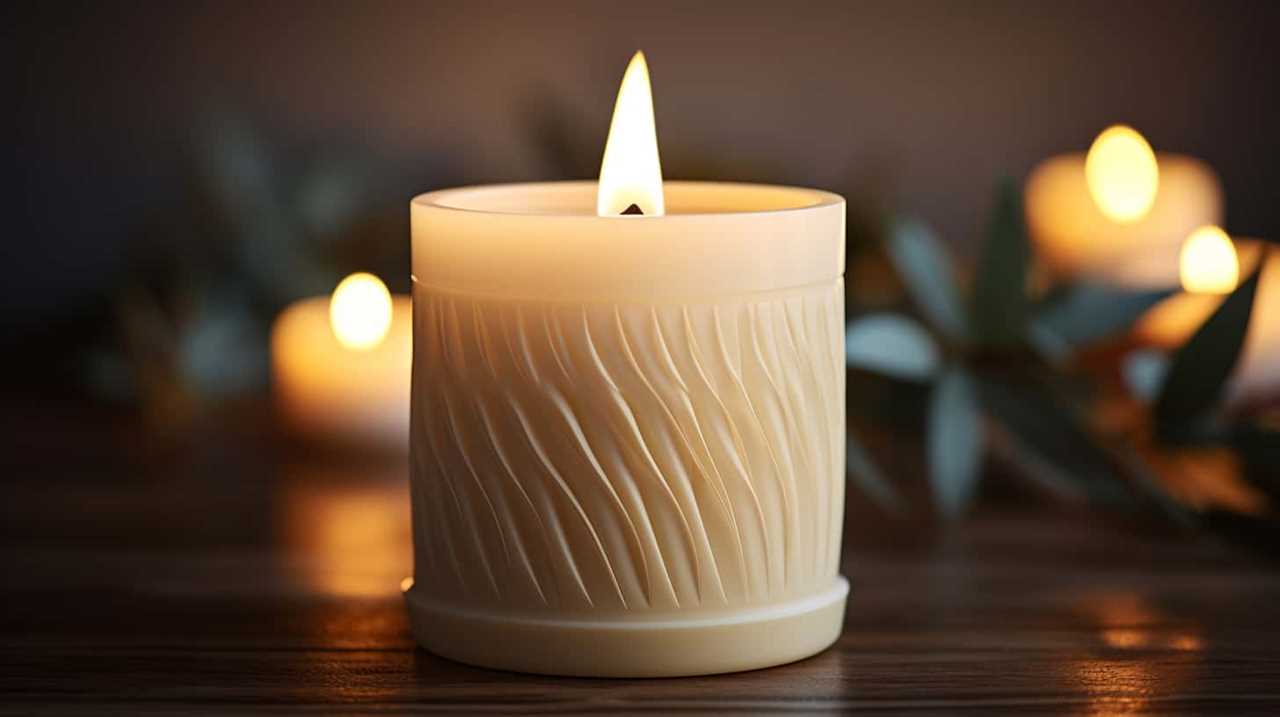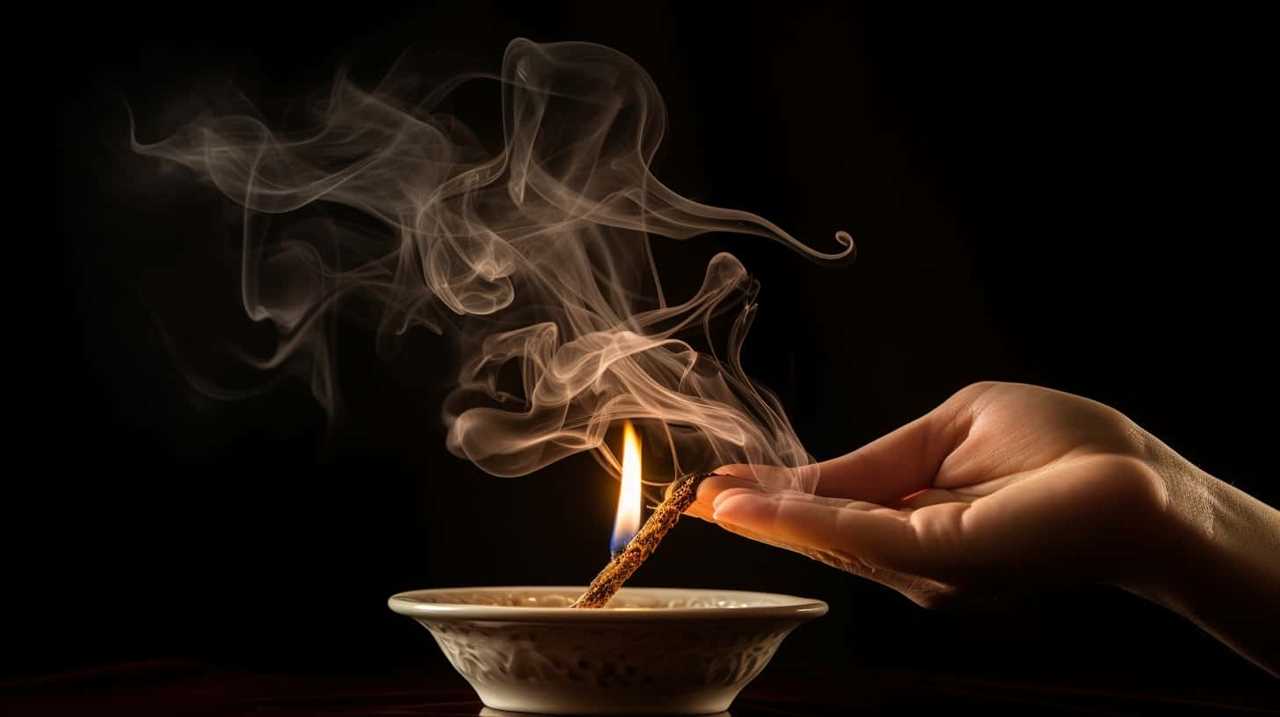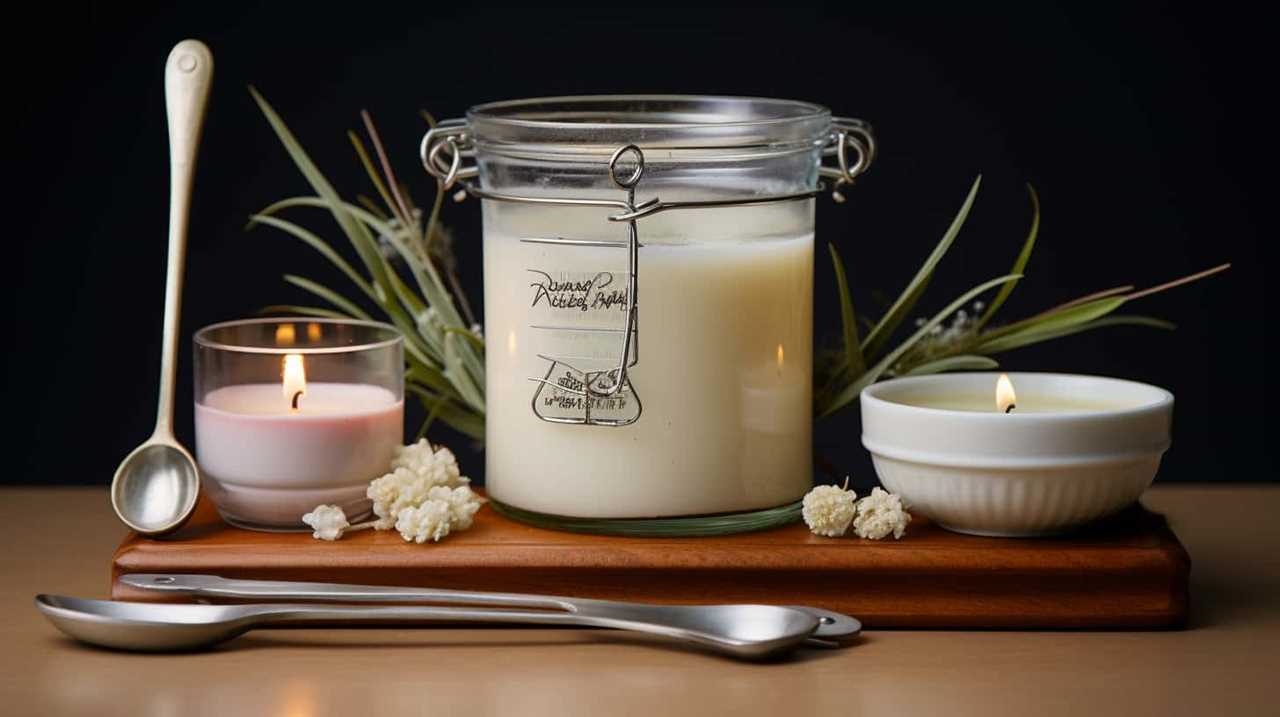Have you ever wondered why your candle wick appears to grow a small mushroom at its center? Let us shed some light on this commonly observed phenomenon for you.
Understanding why candle wicks mushroom can help us serve you better by providing a safer and more enjoyable candle experience. In this guide, we will explore the science behind wick mushrooming, including factors such as wick trim length, candle wax composition, and even flame height.
By delving into the causes and solutions for wick mushrooming, we aim to assist you in preventing this unsightly occurrence and enhancing the longevity of your candles.
So, let’s dive in and uncover the secrets behind why your candle wick mushrooms!

Key Takeaways
- Candle wick mushrooming is caused by carbon deposition and combustion processes.
- Regularly trimming the wick to the recommended length helps prevent mushrooming and ensures a clean burn.
- Factors such as the type of wax used, wick size, and burn rate of the candle can contribute to mushrooming.
- Proper wick trimming, avoiding drafts, and using high-quality wax are important in preventing mushrooming.
Candle Wick Mushrooms: A Common Phenomenon
Candle wick mushrooms, also known as carbon balls or soot balls, are a frequently encountered occurrence during candle wick maintenance. These mushrooms can form on the tip of the wick while the candle is burning. Although they may seem harmless, they can actually cause issues with the performance of your candle.
If you notice mushrooming on your candle wick, it’s important to address the problem promptly. One way to troubleshoot wick issues is by regularly trimming the wick to prevent excessive carbon buildup. This can help reduce the formation of mushrooms.
In addition to trimming the wick, it’s also important to ensure that your candle is not exposed to drafts or excessive air movement. These factors can contribute to mushrooming. By minimizing the exposure to drafts and air movement, you can help prevent the formation of these carbon balls.
Practicing proper candle wick maintenance is crucial for enjoying a clean and efficient burn. It not only prolongs the life of your candles but also enhances the overall experience for those who enjoy them. So, make sure to regularly trim your wick and protect your candle from drafts to keep it burning smoothly.

The Science Behind Mushrooming Wick
The formation of mushrooming wick is a result of carbon deposition and combustion processes. When a candle burns, the heat of the flame vaporizes the liquid wax, causing it to rise up the wick. As the liquid wax reaches the top of the wick, it is exposed to the oxygen in the air and undergoes combustion. During this process, carbon particles are produced and accumulate on the wick, leading to the formation of a mushroom-shaped tip.
To help you better understand the science behind mushrooming wick, here is a table summarizing the causes and prevention techniques:
| Wick Mushrooming Causes | Wick Mushrooming Prevention Techniques |
|---|---|
| High carbon content in the wax | Trim the wick before each use |
| Slow burning rate | Use candles made from quality materials |
| Lack of oxygen | Keep the room well-ventilated |
| Excessive soot | Avoid drafts and keep the candle away from fans or open windows |
| Poor quality wick | Choose candles with high-quality wicks |
Factors Influencing Wick Mushrooming
Factors that contribute to wick mushrooming include the type of wax used, the size of the wick, and the burn rate of the candle. The type of wax used plays a significant role in wick mushrooming. Some waxes, like soy, tend to produce more mushrooming than others, such as paraffin. Additionally, the size of the wick matters. A wick that’s too large for the candle can cause excessive mushrooming. Lastly, the burn rate of the candle affects wick mushrooming. If the candle burns too quickly, it can lead to mushrooming.
To prevent wick mushrooming, ensure you trim the wick to a proper length before each burn. This helps control the size of the flame and reduces mushrooming. Additionally, avoid burning the candle for an extended period, as this can also contribute to mushrooming.

Understanding Wick Trim Length
Understanding the proper length for trimming candle wicks is essential for preventing mushrooming and maintaining a clean burn. By regularly trimming the wick to the recommended length, we can ensure that the flame remains steady and the wax is consumed evenly.
This simple practice not only prevents excessive smoke and soot but also extends the life of our candles, allowing us to enjoy their warm glow for longer periods.
Importance of Wick Trimming
Proper wick trimming plays a crucial role in enhancing candle performance and longevity. Regular wick maintenance is essential for ensuring a safe and enjoyable candle burning experience. By keeping the wick trimmed to the correct length, you can prevent issues such as mushrooming, excessive smoke, and uneven burning.
To understand the importance of wick trimming, let’s take a look at the table below:

| Trim Length | Benefits | Drawbacks |
|---|---|---|
| Too long | – Creates a large flame |
- Increased risk of sooting
- Uneven burning | – High heat
- Wax may melt faster
- Shorter burn time |
| Too short | – Reduces flame height - Decreased risk of sooting
- Even burning | – Low heat
- Wax may not fully melt
- Longer burn time |
| Just right | – Optimal flame height - Minimal sooting
- Even and complete wax melt | – Balanced heat
- Ideal burn time
- Enhanced fragrance release |
Proper Wick Length
To maintain optimal candle performance and prevent issues like mushrooming, we must ensure the wick is trimmed to the right length. Proper wick length is crucial for efficient burning and avoiding excessive smoke or soot. Here are four key points to consider for wick maintenance:
- Trim the wick to 1/4 inch before each use. This helps to control the flame height and prevents the wick from becoming too long.
- Avoid trimming the wick too short. A wick that’s too short may have trouble drawing up enough wax to burn properly, resulting in a weak flame or extinguished candle.
- Regularly check the wick while the candle is burning. If you notice the flame getting too large or flickering excessively, it’s a sign that the wick needs trimming.
- Use proper tools for wick trimming, such as wick trimmers or scissors specifically designed for candles. This ensures a clean and even cut, promoting a consistent burn.
Wick Mushrooming Prevention
To prevent wick mushrooming, we need to ensure that the wick is trimmed to the right length. Proper wick maintenance is crucial for a clean and efficient candle burn. When the wick is too long, it can create excess smoke, soot, and mushrooming.
The ideal wick length is usually around ¼ inch, but it may vary depending on the candle size and wax composition. Trimming the wick before each burn helps to maintain a steady flame and prevents mushrooming. To trim the wick, use scissors or a wick trimmer and remove any charred or mushroomed parts.
Additionally, practicing proper candle burning techniques, such as keeping the candle away from drafts and allowing the wax to melt evenly, can also help prevent wick mushrooming.

Now, let’s delve into the next section about candle wax composition and its effects on mushrooming.
Candle Wax Composition and Mushrooming
When it comes to mushrooming, the composition of the candle wax plays a significant role.
The type of wick material used can affect the amount of mushrooming that occurs.
Additionally, the presence of additives in the wax can also contribute to the formation of mushrooming.

Wick Material Affects Mushrooming
We found that the choice of wick material significantly impacts the occurrence of mushrooming in our candles. Here are four key factors to consider when selecting wick material for optimal performance and reduced mushrooming:
- Material Composition: Different wick materials, such as cotton, hemp, or wood, have varying burn rates and characteristics. Experiment with different materials to find the one that minimizes mushrooming.
- Wick Thickness: Thicker wicks tend to produce more heat, which can lead to increased mushrooming. Opt for thinner wicks that provide a controlled and consistent burn.
- Wick Treatment: Some wicks are treated with chemicals to enhance their performance. However, these treatments can contribute to mushrooming. Look for untreated wicks for a cleaner burn.
- Wick Sizing: The diameter of the wick also affects mushrooming. Choosing the right wick size for your candle’s diameter can help prevent excessive mushrooming.
Impact of Additives on Mushrooming
Our experiments revealed that the addition of certain substances to candle wax can have a significant impact on the occurrence of mushrooming. One such additive that affects mushrooming is fragrance. When fragrance oils are added to candle wax, they can increase the likelihood of mushrooming. This is because the additional substances in fragrance oils can interfere with the combustion process, leading to excessive carbon buildup on the wick.
Another factor that influences mushrooming is the size of the candle. Larger candles tend to have a higher chance of mushrooming compared to smaller ones. This is because larger candles have a larger pool of melted wax, which can contribute to more fuel for the flame and create conditions favorable for mushrooming.
It’s important to consider these factors when selecting candles to minimize the occurrence of mushrooming.

Wick Material and Mushrooming
How can different wick materials contribute to the phenomenon of wick mushrooming? Wick material selection plays a crucial role in determining the performance of a candle wick. Here are four ways in which different wick materials can contribute to wick mushrooming:
- Absorption: Certain wick materials absorb more wax than others, leading to an excess build-up of fuel at the tip of the wick and increasing the likelihood of mushrooming.
- Combustion: Some wick materials burn more slowly or produce a larger flame, causing the wick to generate more heat. This increased heat can contribute to the formation of mushrooming.
- Soot production: Certain wick materials produce more soot when burning, which can accumulate on the wick and contribute to mushrooming.
- Wick size: The diameter of the wick can also impact mushrooming. A wick that’s too large for the candle can result in excessive fuel consumption and mushrooming.
Understanding the relationship between wick materials, wick size, and performance is essential for creating a candle that burns cleanly and efficiently, without excessive mushrooming.
How Flame Height Affects Mushrooming
The flame height of a candle directly influences the occurrence of wick mushrooming. When the flame is too high, it can cause excessive heat and soot buildup, leading to the formation of a mushroom-shaped carbon deposit on the wick. To prevent this, it’s important to control the flame height.
Keeping the flame at a moderate height ensures that the heat is evenly distributed and the combustion process is efficient. To achieve the optimal flame height, trim the wick to approximately 1/4 inch before lighting the candle.

Additionally, avoid placing candles in drafty areas or near vents, as this can cause the flame to flicker and burn unevenly, increasing the chances of wick mushrooming.
Preventing Wick Mushrooming
To prevent wick mushrooming, we can take steps to control the flame height and ensure efficient combustion. Here are some wick trimming techniques that can help prevent common candle wick issues:
- Trim the wick: Regularly trim the wick to about ¼ inch before lighting the candle. This will help maintain a controlled flame height and prevent excessive mushrooming.
- Use a wick trimmer: Invest in a wick trimmer, a specialized tool designed to trim candle wicks. This will ensure a clean cut and prevent any leftover debris from falling into the wax.
- Avoid drafts: Place your candle away from drafts, as they can cause the flame to flicker and lead to uneven burning. This can contribute to wick mushrooming.
- Burn the candle for the recommended time: Follow the manufacturer’s instructions on burning time. Burning a candle for too long can cause the wick to become too long, leading to mushrooming.
Troubleshooting Mushrooming Wick
To troubleshoot mushrooming wick, we can employ simple steps to address this common candle wick issue.
When you notice your candle wick forming a mushroom-like shape at the top, it indicates that the wick is burning too hot and creating excess carbon buildup.

To minimize wick mushrooming, start by trimming the wick to about 1/4 inch before lighting the candle. This will help maintain a controlled flame and prevent excessive heat.
Additionally, ensure that the candle is placed in a draft-free area, as drafts can cause the wick to burn unevenly.
If mushrooming continues, try extinguishing the candle and trimming the wick again.
Frequently Asked Questions
Can Candle Wick Mushrooms Be Harmful to My Health?
Inhaling mushrooming candle wicks can have harmful effects on our health. Long term exposure to these wicks can pose serious risks to our respiratory system. It is important to address this issue for the sake of our well-being.

Are Certain Types of Candle Wicks More Prone to Mushrooming Than Others?
Different types of candle wicks have varying tendencies to mushroom. The materials used, such as cotton or wood, can affect how much mushrooming occurs. Each type has its pros and cons.
Does the Size of the Candle Affect the Likelihood of Wick Mushrooming?
The size of the candle can impact the likelihood of wick mushrooming. It is important to regularly maintain the candle wick to prevent this issue. Proper candle wick maintenance ensures a clean and efficient burn.
What Should I Do if I Notice Mushrooming Wicks in My Candles?
If we notice wick mushrooming in our candles, we should address it immediately. Proper candle wick maintenance is essential for preventing and troubleshooting wick issues. Regularly trim the wick and ensure it is centered for optimal burning.
Can Wick Mushrooming Be Prevented by Using a Specific Type of Candle Wax?
Using a specific type of candle wax can help prevent wick mushrooming. Prevention tips include trimming the wick to 1/4 inch and using alternative wick materials like cotton or hemp.

Conclusion
In conclusion, understanding the reasons behind why candle wicks mushroom can help prevent this common phenomenon. Factors such as wick trim length, candle wax composition, and wick material all play a role in mushrooming.
By properly trimming the wick, using high-quality wax, and choosing the right wick material, you can minimize the chances of your candle wick mushrooming.
So, the next time you light a candle, remember to ask yourself: Are you taking the necessary steps to prevent wick mushrooming?
















